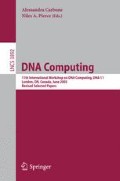Abstract
Here we show that bulk materials can be given new properties through the incorporation of DNA-based nanodevices. In particular, by employing simple nanodevices as crosslinks in polyacrylamide gels we have made the mechanical properties of these gels responsive to the presence of particular DNA strands. Two examples will be focused on here. One consists of a polymer system that can be switched between a sol and a gel state though the application of DNA strands that either form crosslinks or remove crosslinks. The other consists of a hydrogel whose crosslinks incorporate a motor domain. The stiffness of this hydrogel can be altered through the application of fuel strands, which stiffen and lengthen the crosslinks, or through the application of removal strands which remove the fuel strands form the motor domain. Such DNA-responsive gels may find applications in biomedical technology ranging from drug delivery to tissue engineering.
Access this chapter
Tax calculation will be finalised at checkout
Purchases are for personal use only
Preview
Unable to display preview. Download preview PDF.
References
Mao, C., Sun, W., Shen, Z., Seeman, N.C.: A nanomechanical device based on the B-Z transition of DNA. Nature 397, 144 (1999)
Yurke, B., Turberfield, A.J., Mills Jr., A.P., Simmel, F.C., Neumann, J.L.: A DNAfuelled molecular machine made of DNA. Nature 406, 605 (2000)
Simmel, F.C., Yurke, B.: Using DNA to construct and power a nanoactuator. Phys. Rev. E 63, 041913 (2001)
Simmel, F.C., Yurke, B.: A DNA-based molecular device switchable between three distinct mechanical states. Appl. Phys. Lett. 80, 883 (2002)
Yan, H., Zhang, X., Shen, Z., Seeman, N.C.: A robust DNA mechanical device controlled by hybridization topology. Nature 415, 62 (2002)
Yurke, B., Mills Jr., A.P.: Using DNA to power nanostructures. Genet. Program. Evol. Mach. 4, 111 (2003)
Turberfield, A.J., Mitchell, J.C., Yurke, B., Mills Jr., A.P., Blakey, M.I., Simmel, F.C.: DNA fuel for free-running nanomachines. Phys. Rev. Lett. 90, 118102 (2003)
Feng, L., Park, S.H., Reif, J.H., Yan, H.: A two-state DNA lattice switched by DNA nanoactuator. Angew. Chem. Int. Ed. 42, 4342 (2003)
Li, J.J., Tan, W.: A single DNA molecule nanomotor. Nano Lett. 2, 315 (2002)
Alberti, P., Mergny, J.L.: DNA duplex-quadruplex exchange as the basis for a nanomolecular machine. Proc. Natl. Acad. Sci. U.S.A. 100, 1569 (2003)
Dittmer, W.U., Reuter, A., Simmel, F.C.: A DNA-based machine that can cyclically bind and release thrombin. Angew. Chem. Int. Ed. 43, 3549 (2004)
Liao, S.P., Seeman, N.C.: Translation of DNA signals into polymer assembly instructions. Science 306, 2072 (2004)
Sherman, W.B., Seeman, N.C.: A precisely controlled DNA biped walking device. Nano Lett. 4, 1203 (2004)
Shin, J.S., Pierce, N.A.: A synthetic DNA walker for molecular transport. J. Am. Chem. Soc. 126, 10834 (2004)
Lin, D.C., Yurke, B., Langrana, N.A.: Mechanical properties of a reversible, DNA-crosslinked polyacrylamide hydrogel. J. Biomech. Eng. 126, 104 (2004)
Lin, D.C., Yurke, B., Langrana, N.A.: Use of rigid spherical inclusions in Young’s moduli determination: Application to DNA-crosslinked gels. J. Biomech. Eng. 127, 571 (2005)
Lin, D.C., Yurke, B., Langrana, N.A.: Inducing reversible stiffness changes in DNA-crosslinked gels. J. Mater. Res. 20, 1456 (2005)
Nagahara, S., Matsuda, T.: Hydrogel formation via hybridization of oligonucleotides derivatized in water-soluble vinyl polymers. Polym. Gels Networks 4, 111 (1996)
Lin, D.C., Langrana, N.A., Yurke, B.: Force-displacement relationships for spherical inclusions in finite elastic media. J. Appl. Phys. 97, 043510 (2005)
Semler, E.J., Moghe, P.V.: Engineering hepatocyte functional fate through growth factor dynamics: The role of cell morphologic priming. Biotechnol. Bioeng. 75, 510 (2001)
Semler, E.J., Ranucci, C.S., Moghe, P.V.: Mechanochemical manipulation of hepatocyte aggregation can selectively induce or repress liver-specific function. Biotechnol. Bioeng. 69, 359 (2000)
Author information
Authors and Affiliations
Editor information
Editors and Affiliations
Rights and permissions
Copyright information
© 2006 Springer-Verlag Berlin Heidelberg
About this paper
Cite this paper
Yurke, B., Lin, D.C., Langrana, N.A. (2006). Use of DNA Nanodevices in Modulating the Mechanical Properties of Polyacrylamide Gels. In: Carbone, A., Pierce, N.A. (eds) DNA Computing. DNA 2005. Lecture Notes in Computer Science, vol 3892. Springer, Berlin, Heidelberg. https://doi.org/10.1007/11753681_33
Download citation
DOI: https://doi.org/10.1007/11753681_33
Publisher Name: Springer, Berlin, Heidelberg
Print ISBN: 978-3-540-34161-1
Online ISBN: 978-3-540-34165-9
eBook Packages: Computer ScienceComputer Science (R0)

